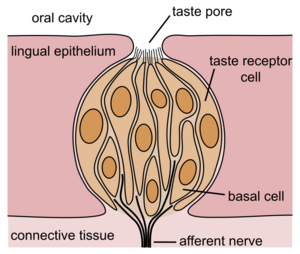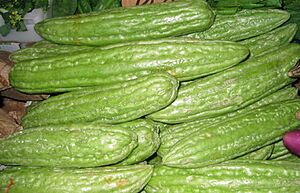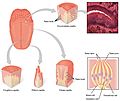Taste facts for kids
Taste is one of your five main senses. It's how humans and animals figure out what they're eating using their tongue. The main tastes we know are sweet, sour, bitter, salty, and savory (also called umami).
Contents
Basic Tastes
Bitterness
Lots of everyday foods taste bitter. Think of coffee, bitter melons, olives, or the peel of a lemon. The taste buds at the back of your tongue are best at tasting bitter things.
Scientists who study how living things change over time are interested in bitterness. Many things found in nature that taste bitter can be harmful if eaten. Being able to taste bitter, harmful things might have helped protect early humans.
Animals that eat a lot of bitter plants, like some deer, have special ways to handle it. They make proteins that help deal with bitter stuff called tannins. Tannins are common in trees and bushes.
Saltiness
Saltiness is what you taste when there is sodium in your food. A common salty spice is regular salt.
Savouriness
Savouriness is the taste of savory foods. It's also known by the Japanese word Umami. This word comes from 'umai', which means 'yummy'. People knew about this taste for a long time, but it only became an official scientific term in 1985.
To taste savoriness, your tongue has special parts that find amino acids. These are found in foods like meats and cheeses.
Sourness
Sourness is what you taste when acids are on your tongue. Many foods have acid in them and taste sour. Good examples are lemons and vinegar.
Sweetness
Sweetness is a taste you feel when sugars are in the food. Most people think sweetness is a very pleasant taste.
Taste-Related Sensations
Spicy or Hot
This feeling is not a basic taste because it doesn't use special taste buds. It's a complex feeling.
Things like capsaicin (from chili peppers) make you feel a burning sensation. This is also called piquance or hotness. Two main sources of this feeling are capsaicin from chili peppers and piperine from black pepper.
Foods like chili peppers directly activate nerve fibers. This gives you the feeling of "hot." Many parts of your body that have exposed skin, but no taste sensors, can feel this heat. For example, your nose, under your fingernails, or even a cut on your skin.
Other Sensations
Your tongue can also feel other sensations that are not usually called basic tastes. These are mostly felt by your body's general sensing system.
Also, your sense of smell and sight help you enjoy food and drinks. The temperature of food also makes a big difference in how much you like it.
The cool feeling you get from spearmint, menthol, and camphor happens because their molecules trigger a sensory system. This system normally works to sense cold temperatures.
There is still a lot to learn about how we taste. Think about the tastes of ginger and horseradish, for example.
Related Pages
- Sweetness
- Umami
| Sensory system |
|---|
| Hearing • Sight • Touch • Taste • Smell • Proprioception |
Images for kids
See also
 In Spanish: Gusto para niños
In Spanish: Gusto para niños





